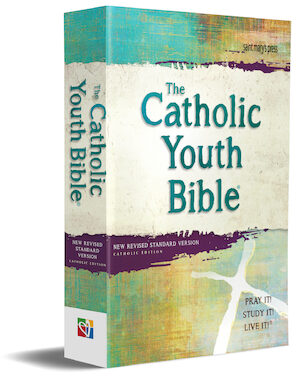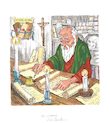Saint Jerome: The Perils of a Bible Translator
About this article
This September 1997 article from St. Anthony Messenger gives new insight into how Catholics read the Bible, tracing that practice back to the fourth century when a young priest was commissioned to produce a Latin text of the Gospels for liturgy. As Latin began to replace Greek as the common language in the western part of the empire, the need for a Bible in Latin was great. Pope Damascus chose Jerome for his trilingual abilities in Greek, Hebrew, and Latin. The article gives background on Jerome's early years and discusses challenges that arose in his work, such as his insistence that original Hebrew texts be used instead of the Greek translation.
“WHAT IS THE BEST TRANSLATION OF THE BIBLE?” This is the question that people who teach biblical studies hear more than any other. A bewildering abundance of alternatives is available to those who want to begin reading the Bible. This long list will grow because the Bible will continue to nourish the faith and life of believers, because scholars will learn more about the ancient languages in which the Bible was written, and because the English language will continue to evolve. New translations of the Bible are a practical necessity.
This is not new. In the fourth century A.D., the language spoken in the Roman Empire began to change. Before that time, Greek was the dominant language. People of every ethnic background in the empire spoke Greek in addition to their native tongue. The Romans encouraged this since they saw themselves as the heirs of Greek culture and civilization.
Gradually Latin, the language spoken by the Romans, began to replace Greek as the common language in the western part of the empire. This had a significant impact on the Church since its Bible was in Greek. The New Testament, of course, was written in Greek. Christians used the Septuagint, a Greek version of the Hebrew Bible, as its version of the Old Testament. (The word septuagint is derived from the Latin word for 70 and is based on a legend that the Greek translation was the work of 70 translators.) Because fewer and fewer Christians in the West could read or understand Greek, the Church faced a serious pastoral problem. How could the Bible remain accessible to believers?
If the Bible were to continue shaping Christian faith and life, it had to be rendered in Latin. Responding to this pastoral need, Christian scholars produced several versions of the Bible in Latin. Unfortunately, none of these has survived to the present. We know them only from citations of individual texts in early theological works.
While these translations made the Bible accessible, they were flawed on two counts. First, they were not the product of careful study of ancient manuscripts. The necessity of copying ancient texts by hand introduced many errors into Greek texts of the Bible. Also, the first Latin Bibles translated the Greek text of the Old Testament—not the Hebrew text. Second, the Latin in these early translations was not the best. It was far too colloquial. None of these Latin translations was authorized and none acquired that position that the Greek had. Pope Damasus wanted a good, serviceable and authorized Latin text of the Gospels for the liturgy. In 382, he commissioned a young priest named Jerome to revise the Latin versions of the Gospels that were in circulation.
Too Smart for His Own Good?
Who was this Jerome the pope chose for this task? Jerome was the pope’s private secretary, but the commission that Damasus gave Jerome was no political appointment. Jerome was a good choice.
Like any good translator, Jerome had a flair for languages. He was “trilingual.” He could speak, write and understand Latin, Greek and Hebrew—something that few others could do. Jerome also studied Aramaic and could read it competently, but he admitted having a problem with pronunciation. He could speak Syriac and had some acquaintance with Arabic.
What made Jerome the logical choice for the pope’s commission in addition to his linguistic competence in the languages of the East was his training in the Latin classics. He began his study of rhetoric in Rome when he was a boy of 12. Donatus, his teacher, was a famous Latin grammarian.
Jerome seems to have reproached himself later in life for the secular color of his education. He wrote that he spent his youth in the company of grammarians, rhetoricians and philosophers. He once had a nightmare in which he saw himself before the judgment seat of God, who asked Jerome, “Who are you?” Jerome replied, “A Christian,” but God corrected him: “You are a liar. You are not a Christian but a Ciceronian.”
When Jerome awoke, he promised to read the books of God with greater fervor than he devoted to his study of “the books of men.” Jerome was uniquely prepared to translate the Scriptures into Latin because he was both a Christian and a Ciceronian. The touch of an outstanding linguist and scholar—like the Roman Cicero—was sorely needed.
Jerome fulfilled his commission by producing a revision of the Gospels. He took care to concern himself not only with his literary craft but also with his own moral response to the Gospel. He must have enjoyed his work because he produced a Latin translation of the Psalms and a few Old Testament books, too. This experience led Jerome to commit himself to a project that occupied him for more than 20 years and proved to be his lasting claim to fame: the translation of other parts of the Bible from the original languages into Latin.
Pope Damasus died in 384. Jerome was a leading candidate to succeed his patron, but another priest of Rome, Siricius, was elected. The new pope did not admire Jerome as much as Damasus had. In addition, Jerome probably did not want to stay in the city that preferred another as its bishop, so he left Rome forever shortly after the new pope took office.
Jerome went first to Antioch, then to Alexandria before settling in Bethlehem in the fall of 386. He was joined by several women whom he had served as spiritual guide while in Rome. Paula, one of these women, founded three convents of women and one for men.
If Jerome had been elected pope, his pastoral responsibilities would have taken all his time and energy. After Jerome arrived at Bethlehem, he began a most productive career as a translator and commentator. He became convinced that producing a good Latin translation required more than simply revising existing translations.
In the case of the Old Testament, Jerome decided that his translation had to consider the Hebrew version of the books. He could not rely on the Septuagint alone. This was not an easy or popular decision. Christians accorded a high status to the Septuagint. Many thought that this Greek version of the Old Testament was itself inspired, making any reference to the Hebrew version unnecessary. Jerome disagreed.
At a time when there were conscious efforts to distance the Church from its Jewish background, Jerome not only went to the Hebrew Bible but also sought help with difficult texts from Jews. In particular, Jerome acknowledged his debt to his Jewish teachers for helping him with the Book of Job whose Hebrew is difficult. Not all Jerome’s fellow Christians appreciated his efforts. They denigrated his translations as being “tainted with Judaism.”
Riots Over Jonah
Saint Augustine was one of Jerome’s opponents. He suggested that, by basing his Latin translation on the Hebrew Bible rather than on the Septuagint, Jerome was driving a wedge between Christians of the East and West since the Greek-speaking Christians of the East were still using the Septuagint.
To illustrate the folly of Jerome’s approach, Augustine told him the tale of a bishop from Tripoli who authorized Jerome’s new translation for use in his church. When the people heard the Old Testament lesson from Jonah, it was so unfamiliar that they protested the bishop’s innovation by rioting in the streets. Augustine saw this as proof that Jerome’s “Hebrew” version was a serious mistake.
Fortunately, not all Christians reacted as did Augustine and the people of Tripoli, but it did take a long time before the Church in the West became accustomed to Jerome’s translation. While no riots appear to have been caused in our century by new translations, many people do feel uncomfortable and complain when they hear familiar biblical stories rendered in unfamiliar words.
As serious as these problems were, Jerome had to deal every day with the practical difficulties of translation. One problem was the character of Latin. In Jerome’s day, it was a fixed language that resisted new vocabulary. But Latin did not have words that corresponded to some of the religious language of the Bible. This required adopting Greek words into Latin or forcing Latin words to bear new meanings. All this made Jerome’s translation sound strange to ears accustomed to the older Latin versions.
A familiar text like the Lord’s Prayer illustrates Jerome’s problems. The Greek word that is rendered as daily in the phrase “Give us this day our daily bread” is not the usual Greek word for daily. In fact, outside the two occurrences in the Matthean and Lucan versions of the Lord’s Prayer, that word occurs only once in all of classical Greek literature. The older Latin versions translated the Greek word as quotidianum (“daily”) in Latin.
Jerome believed this to be inaccurate so he attempted another rendering, which he may have coined himself: supersubstantialem (Matthew 6:11). Not hesitating to change the wording of a text as familiar as the Lord’s Prayer showed Jerome’s courage. At the same time, Jerome was flexible. In his translation of Luke’s version of the Lord’s Prayer, Jerome kept quotidianum (Luke 11:3). In its liturgy, the Church uses the Matthean version of the Lord’s Prayer though it kept quotidianum, which is the basis of all English translations of the prayer. Otherwise, we might be saying, “Give us this day our supersubstantial bread.”
Wary of Word for Word
While Jerome was an accomplished and careful translator, he was not a dogmatic one. He translated idiom for idiom, and not always word for word. For example, he produced at least three translations of the psalms in his attempt to capture and illuminate these prayers of the Church.
Jerome’s translation grated on the ears of contemporaries like Augustine because Jerome’s idea of translation differed from that generally held in his day. Most translators of the Scripture in the era before Jerome believed that the language of the original must dominate the new language. In part, this attitude reflected the belief that the smallest linguistic detail of the biblical text was divinely inspired and had its particular significance. The translator was expected to preserve this by rendering the original as literally as possible.
Jerome believed that a good translator will give the new language equal weight with the original and will try to make the translation equivalent to the original not just in meaning but also in quality of style. Any translation should reflect the new language used at its best—this Jerome learned from Cicero.
The principle that Jerome used as he translated was not “word for word” but “sense for sense.” Today the type of translation that Jerome favored is called “dynamic equivalence” and is found, for example, in The Liturgical Psalter sponsored by the International Committee on English in the Liturgy and published by Liturgical Training Publications of Chicago.
While Jerome may have gotten his idea of what a translation should be from his rhetorical training, he also found a precedent for it in the Bible itself. He remarked on the looseness with which Old Testament passages are cited in the New Testament. Still, he noted that, while the words may differ, the meaning does not. Jerome felt that he had backing from both Cicero and the Bible for avoiding literalism in his translation of the Old Testament.
Narrow Role in a Big Book
The result of efforts to provide a new Latin translation of the Bible is popularly known as the Vulgate, a word derived from the Latin and meaning “common” or “commonly known.” But Jerome was not responsible for the Vulgate as it has come down to us. The only New Testament books he worked on were the Gospels.
It is natural to assume that, after completing his work on the Gospels, Jerome would have then turned to the rest of the New Testament, but there is little evidence that he did. After he published his revision of the Old Latin Gospels, Jerome turned to the Old Testament. In the course of 15 years of work, Jerome translated all the books of the Hebrew Bible.
It is a mistake to identify his work with the Vulgate as it exists today. In Jerome’s time, most manuscripts of the Bible in Latin contained only a few books—not the entire Bible. Assembling manuscripts to make a complete Bible usually meant bringing together manuscripts from a variety of Latin translations. The Vulgate was created by assembling books from a variety of sources, including Jerome. That is how the rest of the New Testament became connected with his work.
As is the case with any new translation, it took a while for people to become accustomed to the new phraseology. They quickly accepted his revision of the Gospels since it had a certain official status. After all, the pope commissioned it. Also, his work on the Gospels was conservative. He did not offer a fresh translation but simply revised the Old Latin translations that were already familiar to readers.
Back to the Beginnings
Translation of the Old Testament was another matter. Jerome undertook translating the Old Testament on his own initiative, so his translation had to achieve acceptance on its own merits. If Jerome had simply revised the Old Latin versions of the Old Testament, his work would have enjoyed more popularity in his lifetime, but Jerome presented an entirely new Latin translation of the Old Testament based on the ancient Hebrew text.
Jerome preferred to base his translation of the Old Testament on the Hebrew Bible with which most Christians were unfamiliar rather than on the familiar Septuagint—at least through the medium of the Old Latin versions. This preference affected not only his translation of Old Testament books but also his view of the Old Testament canon.
The Septuagint contained several books that are not in the Hebrew Bible. The rabbis of Palestine did not regard as inspired the books in the Septuagint that were not also found in the Hebrew Bible. Eventually, all Jews accepted this view and abandoned books like Wisdom, Ecclesiasticus (Sirach), Tobit, Judith, Baruch, and First and Second Maccabees.
Jerome’s view corresponded to that of the rabbis. He believed that, while these “extra books” may edify Christian readers, the Church should not use them as a source for doctrine. Again, Augustine opposed Jerome. In this instance, Augustine’s view prevailed.
Eventually, the Council of Trent opted for the wider canon probably because the Reformers chose to accept only books of the Hebrew Bible. That is why the Old Testament read by Catholics contains seven more books than the Old Testament read by Protestant Christians.
Irascible Biblical Commentary
Jerome was more than a translator of the Bible. He was a gifted interpreter as well. His major contribution was a series of commentaries on the prophets. At first, Jerome followed the approach common in his day. For example, his commentary on Obadiah was allegorical. He ignored the historical dimensions of the prophet’s words and focused on a spiritual interpretation that sought to edify readers.
While Jerome never completely abandoned allegorical interpretation, his work as a translator led him to appreciate the historical and literal approach more. He sought to understand the biblical text in its original cultural and historical setting. Many students of the Bible find Jerome’s commentaries still helpful.
Jerome’s commentaries were not esoteric flights of scholarly fancy. The irascible scholar sometimes used his role as a biblical commentator to give his opinion on ecclesiastical controversies of his day, some of which were occasioned by his work. His comments sometimes use personal invective against his opponents that, by today’s standards, seems harsh and sarcastic.
For example, Jerome had a running quarrel with another Christian commentator named Rufinus. In the Preface to his translation of the Book of Ezekiel, Jerome wrote of the recently deceased Rufinus: “Now that the scorpion lies buried....” He once described the heretic Pelagius as the most stupid of persons whose wits were dulled by too much Scottish porridge.
Jerome did not even spare the biblical prophets. He remarked that the quality of their rhetoric made his skin crawl. Reading Jerome’s commentaries and his 117 surviving letters leads to the conclusion that Jerome loved a good argument.
Kind Toward His Friends
As merciless and abusive as Jerome was toward his opponents, he was gentle and kind toward his friends and the needy. Many people sought his advice as they tried to live out their Christian lives. He founded a school for boys at Bethlehem and served as a spiritual guide for the monks and nuns who settled in Bethlehem to be near him. He gave shelter to refugees who came to the Holy Land following the sack of Rome by the Vandals in 410.
It is also clear that Jerome had a great and abiding respect for ecclesiastical authority. He spent some time in Antioch, which at the time of his visit had three rival bishops. Jerome asserted that he would accept the bishop in union with Rome. All three professed loyalty to the See of Saint Peter so Jerome waited until the pope chose to support one of the three competing bishops. Jerome accepted ordination to the priesthood from Paulinus, the bishop that Rome approved.
Jerome was among the most learned Christians of his day. He put his learning to the service of the Church and became the greatest biblical scholar of the early Church. He has been considered a Father of the Church since the eighth century and the Council of Trent proclaimed him a Doctor of the Church. His writing style was exceptional and he used it to offer the Church a translation of the Old Testament that was the best available to the Latin-speaking Christians of his day.
The contradictions of his personality may be more apparent than those of others whom the Church honors as saints. Still, no one can read his commentaries without recognizing that the Bible was not simply an interesting literary work but the source of Spirit and life for Jerome.
Historical Repeats
Can Jerome help those who are looking for a good translation of the Bible? Jerome would, of course, expect those who preach and teach the Bible to read it in the original Hebrew, Aramaic and Greek as he did. For those who cannot do this, but still want to engage in serious study, he would suggest a literal translation such as found in the Revised Standard Version and the New American Bible.
Jerome would also favor a translation that used the method of “dynamic equivalence” like The Liturgical Psalter of the International Committee on English in the Liturgy since it seeks to render the psalms “sense for sense” rather than “word for word.” This makes the psalms more accessible to those who wish to pray them today.
Finally, Jerome would know exactly what the translators of the New American Bible psalter are going through. It is almost five years since the American bishops asked that this psalter be approved by Rome for use in the liturgy. Approval has still not come. Jerome’s translation did not achieve wide acceptance in the Church until centuries after his death.
There is no other person who has had greater influence on the way Catholics read the Bible than Saint Jerome. He had worried that his influence would be restricted to aesthetics rather than to faith. His worries were groundless because Jerome was a sincere believer who used his talent and education to help other believers find, as he did, that the Scriptures are the Word of God—the word of life.
Leslie J. Hoppe, a Franciscan friar of the Assumption Province, has been Professor of Old Testament Studies at Catholic Theological Union in Chicago since 1981. Father Hoppe holds a Ph.D. in religion from Northwestern University and is a member of the editorial boards of The Bible Today and Old Testament Abstracts. He is the author of six books, and his articles have appeared in both scholarly and popular magazines. He is currently writing A Retreat With Saint Luke for Saint Anthony Messenger Press.
Acknowledgments
© Copyright St. Anthony Messenger Press. This article was published with the permission of St. Anthony Messenger magazine, which provides study guides to accompany many of its articles. You can access these guides by going to the magazine's Links for Learners page. Teachers will find a wealth of other resources at the St. Anthony Messenger Press web site by visiting this link: http://www.americancatholic.org/features/learners/Published September 1, 1997.





